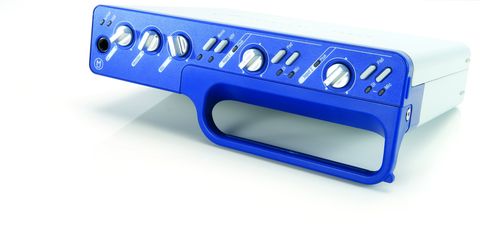The Mbox 2 is the latest package to be based on the Pro Tools LE software, and first impressions are excellent. The audio hardware is both stylish and sturdy, and the front panel controls shout ‘quality´ in a loud voice.
The unit is lightweight enough to be truly portable, yet hefty enough to suggest that there´s an abundance of high-quality electronics inside. It´s completely USB-powered, which will please laptop users who don´t want to have to carry and use an external power supply.
The Mbox 2´s front panel knobs and buttons are cleverly labelled at a 45-degree angle, making them equally readable whether you choose to place the unit flat on a desktop or upright on its edge (useful when your working conditions are very cramped). This might seem like a minor point, but it´s indicative of the close attention to detail that Digidesign pay to their products -- and such details really are important. It´s also nice to see electronically balanced monitor output sockets, as these are vital when you´re using active monitor speakers.
Irrespective of the technical specifications of those monitor output sockets, subjectively, they seem to be utterly noiseless. When no audio is playing you can turn the monitor volume up to full blast and hear no hint of hum, hiss or background noise. This is clearly a product of unusually high quality. On the front panel you get a comfortably loud headphone socket with its own level control. Thankfully, this is completely independent of the monitor outputs and their level control.
There are buttons to enable phantom powering, switch between input sources and enable a pad, and you also have the ability to mono the input monitor signal. If you don´t like the slightly weird looking carrying handle, you can replace it with a blank cover that comes supplied in the box. The back panel gives you phantom-powered XLR mic inputs, balanced line inputs, and high-impedance ‘DI´ instrument input sockets.
Alongside the monitor output sockets there´s coaxial S/PDIF I/O and also the MIDI In and Out sockets. In short, you get everything you need in a single-person project studio, although it´s important to note that Mbox 2 is only capable of 44.1kHz/48kHz operation - no higher quality sampling rates are available.
Special versions
As well as the host software (the feature-light LE version of Pro Tools), you also get ‘special´ versions of Ableton Live, Reason, SampleTank, T-RackS EQ, AmpliTube, FXpansion´s BFD and Celemony´s Melodyne. Yes, these are all cut down models of the retail products, but it´s a generous number of seriously cool toys nonetheless.
What´s more, you can upgrade to the full versions of any of these products in the future. For an extra £70, you can buy the Factory version of Mbox 2, which ships with five extra plug-ins. Pro Tools LE looks and feels very similar to its big brother, but the development strategy that´s been adopted for this cutdown edition does annoy us slightly.
You can´t really complain about advanced technology being withheld from cut-price versions of software products, but putting artificial limits on the number of audio tracks you can use (just 16 stereo or 32 mono) and - perhaps more critically - cutting the amount of internal signal routing (used for vitally important grouping and send effects tasks) to just eight stereo busses really does seem mean-spirited. We hope that Digidesign will have a bit of a rethink in the future, or excellent products like the Mbox might not get the market share that they deserve.
Tools of the trade
In terms of hardware features, it´s true that the Mbox 2 isn´t in the same league as the Focusrite Saffire but this is missing the point. With the Mbox 2, you´re buying into a music production environment that´s been tried and tested by top producers for many years - it has a pedigree that´s beyond reproach.
However, if you´re new to computer music production then you may find learning to use Pro Tools LE to be something of an uphill struggle - it´s fair to say that products such as Ableton Live are more accessible, more creative and, perhaps most importantly, much more fun to use. That said, total compatibility with major-league recording studios and record producers is important to some people, and Mbox 2 lets you swim with the big fish without taking too huge a bite out of your budget.


